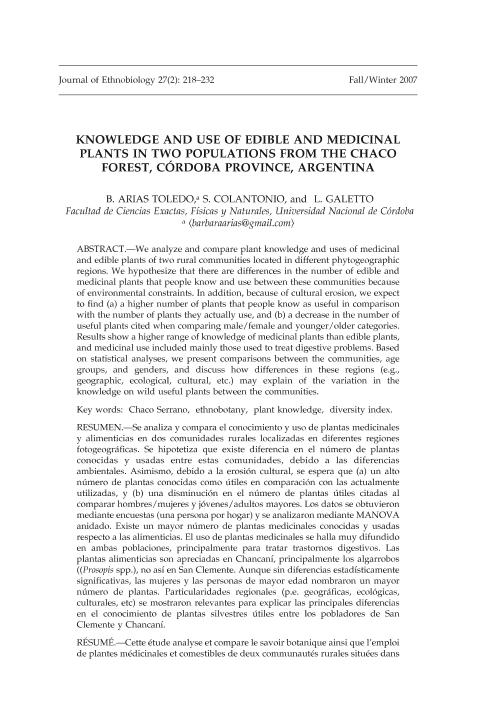Artículo
We analyze and compare plant knowledge and uses of medicinal and edible plants of two rural communities located in different phytogeographic regions. We hypothesize that there are differences in the number of edible and medicinal plants that people know and use between these communities because of environmental constraints. In addition, because of cultural erosion, we expect to find (a) a higher number of plants that people know as useful in comparison with the number of plants they actually use, and (b) a decrease in the number of useful plants cited when comparing male/female and younger/older categories. Results show a higher range of knowledge of medicinal plants than edible plants, and medicinal use included mainly those used to treat digestive problems. Based on statistical analyses, we present comparisons between the communities, age groups, and genders, and discuss how differences in these regions (e.g., geographic, ecological, cultural, etc.) may explain of the variation in the knowledge on wild useful plants between the communities. Se analiza y compara el conocimiento y uso de plantas medicinales y alimenticias en dos comunidades rurales localizadas en diferentes regiones fotogeográficas. Se hipotetiza que existe diferencia en el número de plantas conocidas y usadas entre estas comunidades, debido a las diferencias ambientales. Asimismo, debido a la erosión cultural, se espera que (a) un alto número de plantas conocidas como útiles en comparación con las actualmente utilizadas, y (b) una disminución en el número de plantas útiles citadas al comparar hombres/mujeres y jóvenes/adultos mayores. Los datos se obtuvieron mediante encuestas (una persona por hogar) y se analizaron mediante MANOVA anidado. Existe un mayor número de plantas medicinales conocidas y usadas respecto a las alimenticias. El uso de plantas medicinales se halla muy difundido en ambas poblaciones, principalmente para tratar trastornos digestivos. Las plantas alimenticias son apreciadas en Chancaní, principalmente los algarrobos ((Prosopis spp.), no así en San Clemente. Aunque sin diferencias estadísticamente significativas, las mujeres y las personas de mayor edad nombraron un mayor número de plantas. Particularidades regionales (p.e. geográficas, ecológicas, culturales, etc) se mostraron relevantes para explicar las principales diferencias en el conocimiento de plantas silvestres útiles entre los pobladores de San Clemente y Chancaní.
Knowledge and use of edible and medicinal plants in two populations from the Chaco forest, Córdoba province, Argentina
Fecha de publicación:
09/2007
Editorial:
Society of Ethnobiology
Revista:
Journal Of Ethnobiology
ISSN:
0278-0771
Idioma:
Inglés
Tipo de recurso:
Artículo publicado
Clasificación temática:
Resumen
Palabras clave:
Plant Knowledge
,
Medicinal And Edible Plants
,
Rural Communities
,
Argentine
Archivos asociados
Licencia
Identificadores
Colecciones
Articulos(CIECS)
Articulos de CENTRO DE INVESTIGACIONES Y ESTUDIO SOBRE CULTURA Y SOCIEDAD
Articulos de CENTRO DE INVESTIGACIONES Y ESTUDIO SOBRE CULTURA Y SOCIEDAD
Articulos(IMBIV)
Articulos de INST.MULTIDISCIPL.DE BIOLOGIA VEGETAL (P)
Articulos de INST.MULTIDISCIPL.DE BIOLOGIA VEGETAL (P)
Citación
Arias Toledo, Barbara; Colantonio, Sonia Edith; Galetto, Leonardo; Knowledge and use of edible and medicinal plants in two populations from the Chaco forest, Córdoba province, Argentina; Society of Ethnobiology; Journal Of Ethnobiology; 27; 2; 9-2007; 218-232
Compartir
Altmétricas




